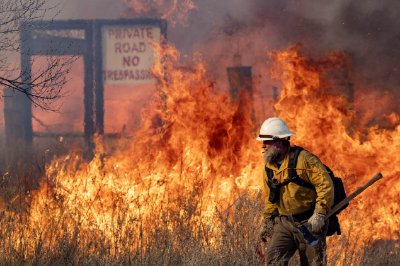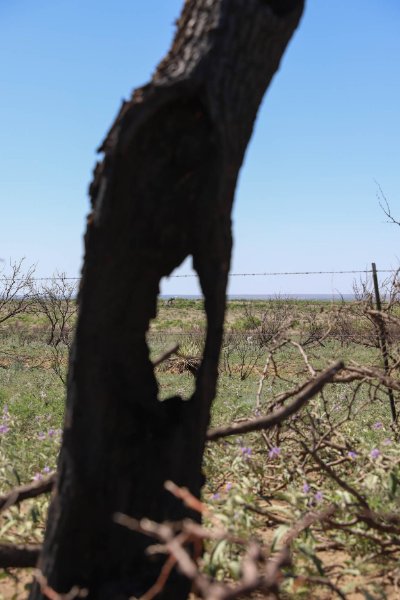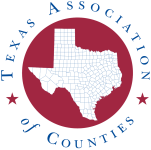County Magazine | July 29, 2024
Nature on a tear
In disaster-battered Texas Panhandle, counties show resilience

Driving along the back roads of Hutchinson County in early summer, there’s no destruction as far as the eye can see. Few would have guessed that just a few months before, the largest wildfire in Texas history engulfed this small Panhandle county, decimating some 1.2 million acres, and taking the lives of thousands of cattle.
Now vibrant with green grass and fields covered in super blooms, the region has seemingly recovered from the Smokehouse Creek Fire. But as one resident aptly put it: “The land recovers a lot faster than the people.”
It is just one of the many recent tragedies that now characterize the Texas Panhandle. During the past few years, the region has faced a series of disasters, with county government on the front lines of several events: deadly tornadoes, deadly wildfires, flash flooding, extreme drought and animal disease outbreak.
And many struggle to bear the lingering thought of the next tragedy.
Tinder box: Decades of historic wildfires in the Panhandle
During late February, five wildfires engulfed the Panhandle, creating unprecedented challenges for those at the forefront of the disaster. The Smokehouse Creek Fire, ignited by a downed utility pole, quickly made a name for itself, becoming the state’s largest wildfire within a day.
Although it wasn’t the first disaster for emergency personnel, it was easily one of the most daunting, said Hutchinson County Emergency Management Coordinator Jerry Langwell.
“It was really difficult even trying to manage – well not even manage, but just trying to rein in the chaos a little bit,” he said. “The stress level of this kind of event is out the roof, and it definitely takes a toll on people’s mentality if their physical well-being is just exhausted.”
Over the course of three weeks, firefighters from across the state and country worked tirelessly around the clock to extinguish the colossal blaze. It consumed everything in its path, destroying hundreds of structures and resulting in the death of more than 7,000 head of cattle – in what is the largest cattle-producing region in the country and already suffering from severe drought.

“We wanted to be able to get out there and do more for the grasslands and the cattle and the structures, but the people are more important,” Langwell said.
“But it’s also the livelihood for these people. This is what they do, and this is how they live, and to say that we don't have the resources just due to the sheer size of the incident is pretty tragic.”
At least three dozen wildfires have encroached on communities and ranches in the Panhandle since 2005.
In 2017, a downed power line ignited a wildfire in Pampa that scorched 135,000 acres and several ranches in totality. The Lefors East Fire was the third-deadliest wildfire in the state, taking the lives of three people, including a couple trying to save cattle from a ranch in Gray County.
On Mother’s Day in 2018, a wildfire ignited in the Lake Meredith Harbor, and the 2014 Double Diamond fire destroyed 224 structures – both in Hutchinson County.
Additionally, the Panhandle claims four of the 10 most destructive wildfires, including both the largest and second largest on record in terms of acreage. Hutchinson County also saw the deadliest wildfire in the state after the East Amarillo Complex Fire led to 13 fatalities in 2006.
Inevitably, this means counties strive even more diligently to prevent wildfires, Langwell said. This includes the implementation of burn bans when the land is too dry and maintaining landscapes within county jurisdiction, but predominantly the responsibility lies in the hands of residents.
Langwell said residents must be properly educated on wildfire disaster prevention, especially with their proximity to grasslands – which is a greater fuel for wildfires than forests. Controlled burns, vehicle maintenance and proper landscaping are just some of the ways to prevent wildfires, he said.
“Up here, we can burn a million acres in a day and a half,” Langwell said. “And that's just unheard of anywhere else.”
Beyond the scorching impact of wildfires, Hutchinson County has also recently faced ice storms, flooding, extreme drought and tornadoes. And with each new disaster comes new efforts to protect the community. Among those include improvements toward early warning systems and public alerts, a testament to the county’s commitment to public safety and its approval of funds for every emergency management project Langwell has requested.
These initiatives include implementing advanced notification systems such as Everbridge and reverse 911. The county installed 27 new outdoor warning sirens, intended for tornadoes, about three weeks before the most recent wildfires and was able to use them during the disaster.
“A lot of times when I wrote emergency plans, it was always, ‘If this happens, we can do this.’ Now, it’s an all-encompassing plan that is fluid, and I’m always adjusting things to whatever situation comes up,” Langwell said, using an example of the tornado that crossed the lake in his backyard just three days prior.

A land of learning: How tragedy has shaped the panhandle
They say tornadoes never strike the same place twice, but that’s merely myth, as proved in Ochiltree County during the past year.
In June 2023, an EF-3 tornado – which has wind speeds between 136 and 165 mph – plunged through the tiny town of Perryton on the Texas-Oklahoma border, about 110 miles north of Amarillo, quickly transforming into a movie scene as remnants of collapsed buildings and piles of rubble covered the downtown square of the 8,000-person town. In total, three died and more than 100 suffered injuries.
In a rare event, another EF-3 hit the High Plains region – combined of the South Plains and Panhandle – and killed four in Motley County just six days later. It was one of only three times that the region has experienced multiple deadly tornadoes during the same year.
And just as locals began to return to normality, and the remainder of Panhandle began to recover from the wildfires in late March, another tornado, rated EF-0 with winds between 65 and 85 mph, touched down two miles south of Perryton, damaging the roof of the Ochiltree County General Hospital.
Ochiltree County Chief Deputy Wayne Floyd was at the forefront of recovery efforts for both tornadoes in his county, and he said each was a different experience.
“We live pretty north and we can get big ice storms or we can get 70 mph winds – and that’s just the way wind blows that day,” Floyd said. “We have to be prepared for it all.”
For instance, after the EF-3 tornado hit town in 2023, county staffers helped develop a response plan in case the hospital was ever hit by a tornado. When the March 2024 tornado damaged the hospital, county workers knew how to mobilize, Floyd said.
As more tragedies occur, Floyd – like Langwell – has become more meticulous in his planning, which recently has included implementing a mobile command center. Based in a vehicle, the command center, medical personnel and other emergency response teams can be on the ground more when managing public emergencies – especially in rural areas that could be many miles from the primary brick-and-mortar emergency center.
Despite the ease of feeling discouraged while living in a disaster-prone place, Floyd praised his community for its resilience – but most importantly, for people’s desire to unite and help one another through times of tragedy.
“The people up here are some of the greatest people in the world,” Floyd said.

